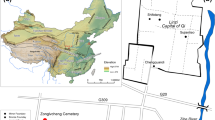Abstract
The present case study concerns the technology of Byzantine wall paintings from the Mani Peninsula, Greece. An assemblage of 12 Byzantine churches, constructed in the tenth to fifteenth century, was included in an initial analytical survey. Two random samples of wall paintings were taken in each monument in order to study their micro stratigraphy and the composition of pigment and plaster layers. Polished sections were fabricated for examination with optical microscopy and scanning electron microscopy (SEM). Furthermore, selected samples were powdered and analysed with Fourier-transformed infrared spectroscopy (FTIR) and X-ray diffraction (XRD). The analytical results achieved in this case study provided general conclusions concerning painting techniques for wall paintings in a rather provincial area of the Byzantine Empire. The palette comprised mainly earthen pigments like ochres and carbon black but occasionally also other pigments like cinnabar, minium and ultramarine. In view of future studies, a portable X-ray fluorescence analysis (XRF) set-up was tested.

Section of an ultramarine paint layer from the Church Aghios Philippos






Similar content being viewed by others
References
Winfield DC (1968) Middle and Later Byzantine wall painting methods—a comparative study. Dumbarton oaks paper 22:61–142
Daniilia S, Tsakalof A, Bairachtari K, Chryssoulakis Y (2007) The Byzantine wall paintings from the Protaton Church on Mount Athos, Greece: tradition and science. J Arch Science 34:1971–1984
Cennini C (1960) The craftman’s handbook ‘Il Libro dell’Arte’ Cennino d’Andrea Cennini (translated by D.V. Thompson). Dover, New York
Hawthorne JG, Smith CS (1979) Theophilus on divers art: the foremost medieval treatise on painting, glassmaking and metalwork. Dover, New York
Panayotidi M (2005) Les villages dans l’Empire byzantine IVe-XVe siècle (eds. J.Lefort-C.Morrisson-J.P.Sodini ). Réalités Byzantines 11:293–212
Sianoudis I, Drakaki E, Hein A (in press) Educational X-ray experiments and XRF measurements with a modified, mobile system adapted for characterization of Cultural Heritage objects. Verhandlungen: Didaktik der Physik—Fruehjahrstagung Bochum 2009, Deutsche Physikalische Gesellschaft
Hradil D, Grygar T, Hradilova J, Bezdicka P (2003) Clay and iron oxide pigments in the history of painting. Appl Clay Sci 22:223–235
Aze S, Vallet JM, Baronnet AM, Grauby O (2006) The fading of red lead pigment in wall paintings: tracking the physico-chemical transformations by means of complementary micro-analytical techniques. Eu J Mineral 18(2):835–843
Deer WA, Howie RA, Zussman J (1992) An introduction to the rock-forming minerals. Longman, Harlow, Essex
Holley EA, McQuillan AJ, Craw D, Kim JP, Sander SG (2007) Mercury mobilization by oxidative dissolution of cinnabar (α-HgS) and metacinnabar (β-HgS). Chem Geol 240:313–325
Awatani TM, McQuillan AJ (1998) Adsorbed thiosulfate intermediate of cadmium sulfide aqueous photocorrosion detected and characterized by in situ infrared spectroscopy. J Phys Chem B 102:4110–4113
Rampazzi L, Bugini R (2006) St. Lorenzo Basilica in Milan: integral approach to characterisation of historic mortars. e-PreservationScience 3 (http://www.morana-rtd.com/e-preservationscience/TOC.html):21-26
Bikiaris D, Daniilia S, Sotiropoulou S, Katsimbiri O, Pavlidou E, Moutsatsou AP, Chryssoulakis Y (1999) Ochre-differentiation through micro-Raman and micro-FTIR spectroscopies: application on wall paintings at Meteora and Mount Athos, Greece. Spectrochim Acta Part A 56:3–18
Bruni S, Cariati F, Casadio F, Toniolo L (1999) Characterisation of ancient magnesian mortars coming from northern Italy. Vib Spectrosc 20:15–25
Gadsden JA (1975) Infrared spectra of minerals and related inorganic compounds. Butterworth, London
Mateo MP, Ctvrtnickova T, Nicolas G (2009) Characterisation of pigments used in painting by means of laser-induced plasma and attenuated total reflectance FTIR spectroscopy. Appl Surf Sci 255:5172–5176
Genestar C, Pons ΖC (2005) Earth pigments in painting: characterisation and differentiation by means of FTIR spectroscopy and SEM-EDS microanalysis. Anal Bioanal Chem 382:269–274
White WB (1974) The carbonate minerals. In: Farmer VC (ed) The infrared spectra of minerals. Mineralogical Society, London
Bruni S, Cariati F, Fermo A, Pozzi A, Toniolo L (1998) Characterisation of ancient magnesian mortars coming from northern Italy. Thermochim Acta 321:161–165
Villasenor I, Price CA (2008) Technology and decay of magnesian lime plasters: the sculptures of the funerary crypt of Palenque, Mexico. J Arch Science 35:1030–1039
Maravelaki-Kalaitzaki P, Bakolas A, Karatasios I, Kilikoglou V (2005) Hydraulic lime mortars for the restoration of historic masonry in Crete. Cem Concr Res 35(8):1577–1586
Bronk H, Röhrs S, Bjeoumikhov A, Langhoff N, Schmalz J, Wedell R, Gorny H-E, Herold A, Waldschläger U (2001) ArtTAX—a new mobile spectrometer for energy-dispersive micro X-ray fluorescence spectrometry on art and archaeological objects. Fresenius' J Anal Chem 371:307–316
Acknowledgements
The analytical work was part of a project on Byzantine wall paintings coordinated by M. Panayotidi and S. Kalopissi-Verti at the University of Athens, which has been funded by EPEAK II/ PYTHAGORAS II. The measurements with the portable XRF were carried out at the TEI of Athens in collaboration with I. Sianoudis.
Author information
Authors and Affiliations
Corresponding author
Rights and permissions
About this article
Cite this article
Hein, A., Karatasios, I. & Mourelatos, D. Byzantine wall paintings from Mani (Greece): microanalytical investigation of pigments and plasters. Anal Bioanal Chem 395, 2061–2071 (2009). https://doi.org/10.1007/s00216-009-2967-6
Received:
Revised:
Accepted:
Published:
Issue Date:
DOI: https://doi.org/10.1007/s00216-009-2967-6




